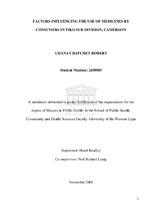| dc.description.abstract | Irrational use of medicines is a global health problem. The World Health Organization has reported that more than 50% of all medicines are prescribed, dispensed and sold inappropriately, and that more than 50% of patients fail to take their medicines correctly (Holloway, 2006). The rational use of medicines is one of the core components of the National Strategic Plan for the Implementation of a Pharmaceutical Policy in Cameroon (MOH, 2000). In Cameroon, it has been noted that instead of going to the hospital when
they fall sick, consumers prefer to self-medicate or visit a street vendor, traditional or faith healer or quack doctor (World Bank, 1995) and that they adjust the quantity of medicines they take based on their ability to pay for them (van der Geest, 1991). Aim and Objectives This study described the factors influencing the use of medicines by consumers in Tiko sub-division at household level, community level, health institutions level, and national
level. Study Design This study used a qualitative study design to explore the factors influencing the use of medicines by consumers in Tiko-subdivision, Cameroon. Study Population and Sampling Six focus group discussions with consumers representing the different socio-economic and educational levels of Tiko sub-division were conducted. Two focus groups with members of each of the following organizations - Plantain Traders Association, Township Taxi Drivers Association and Teachers of Tiko High School. Six in-depth interviews with key informants were carried out, three with workers that sell medicines in
community pharmacies and three with workers that sell medicines in the informal sector. Data Collection and Analysis Notes and observations were taken during the focus groups and key informant interviews. In addition, the proceedings were audio taped and the recordings were used to expand and clarify the notes. The data obtained was analyzed to identify recurring themes from the various influences of medicine use on consumers.
Results Factors that influenced consumers’ use of medicines were categorized into household, community, health institutional and national levels. At the household level key influences were the consumers’ perceived need for medicines, the cost of medicines, the purchasing habits of consumers, the literacy level and consumers’ idea about efficacy and power of medicine, together with polypharmacy and polytherapy. At the community level, the
medicine use culture, medicine supply channels and the sources of information of medicines influenced consumers’ use of medicines. At the health institutional level the influences reported were the quality of services, the cost of medicines, availability of medicines and consulting health worker. At the national level factors included, the media, lack of medicines regulation and control and medicines financing mechanisms. Discussion The study found that medicines use in Tiko sub-division was affected by a number of key factors. A number of cross-cutting themes were identified which had a critical impact on the rational use of medicines by this community. These themes were categorized as: sociocultural, economic and regulatory .Amongst the sociocultural factors was the way consumers perceived their need for medicines, their ideas about efficacy and the power of medicine and their perception of medicines as a commodity. Economic factors included user charges for health care - including medicines, and the high cost of medicines, while regulatory factors emanated from the illicit trade in pharmaceuticals, poor regulatory control and the lack of a national drug policy. Recommendations Proposals to improve the rational use of medicines by consumers in Tiko sub-division were identified to remove the sociocultural, economic and regulatory barriers to appropriate medicines use. Sociocultural strategies should focus on public education on medicines through role plays and audiovisual communication tools increase knowledge about medicines and to ensure behaviour change. Economic strategies should include the elimination of user charges and health financing strategies. Regulatory strategies proposed include amongst others, implementation of a national medicines policy and the setting up of a multisectoral task force to control sales of medicines. | en_US |

